Black Holes Hanging Out Together
By BellatrixIt has been observed for some time now that most large galaxies have super massive black holes at their center. It is generally believed that all galaxies have a central black, but some have thought for a while now that large galaxies may have more than one central black hole. However, until very recently a binary black hole system had never been observed. Astronomers from the National Optical Astronomy Observatory, NOAO, in Tucson AZ have found what they believe is the first binary system of two massive black holes.
The astronomers from NOAO used data from the Sloan Digital Sky Survey, SDSS, to look at quasars billions of light years away. More than 100,000 quasars are known while the astronomers for this study looked at 17,500 quasars from SDSS data. A quasar is a quasi-stellar radio source; a powerfully energetic and distant galaxy with an active nuclei. They are hundreds of times brighter than our own galaxy and powered by matter falling into the black hole, or accreting, and as the matter falls in it heats up dramatically causing a luminous glow.
Astronomers are able to use “see” the central black hole by looking for a particular signature in the radiation coming from the in falling matter. Now with two central black holes they would be too close together to actually distinguish their own accretion disks however there should be a characteristic dual signature in the emission lines. It was this distinct signature that NOAO astronomers were looking for, and believe they have found.
Once the signature was detected the scientists had to rule out the possibility that it was coming from two separate galaxies in the same line of sight superimposed on each other. It took some work but they were able to determine that the emissions were coming form the same distance with only one possible host galaxies. The double set of broad emission lines is pretty conclusive evidence that what was being seen is a binary black hole system. The smaller of the two black holes is estimated at about 20 million solar masses while the larger one is about 50 times bigger, as determined by their orbital velocities.
This is an exciting discovery as it is the first of its kind. Further study can be used to research theories on galaxy mergers, super massive black hole evolution, and theories on gravity and relativity. It is theorized that galaxy mergers happen frequently and if each galaxy had a central black hole a merger would create a binary like this one. This theory also predicts that the two black holes will eventually merge themselves, evidence of which should, if theory is correct, be observable within the next few years. Also this is an ideal place to study theories of gravity and relativity, as the gravitational pull from a massive black hole binary system would be so strong gravitational effects not normally observable would be present. It should be quite interesting to see what research and information comes from further study of this system.
